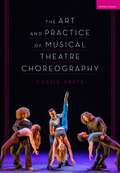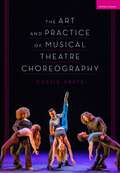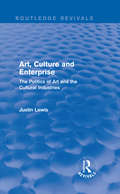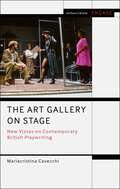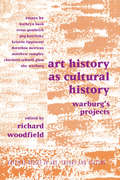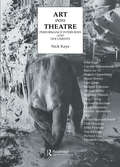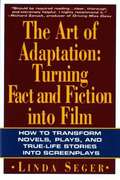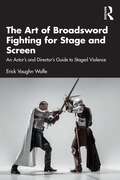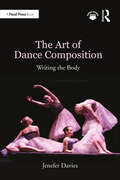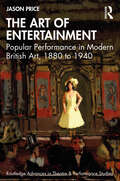- Table View
- List View
The Art and Practice of Musical Theatre Choreography
by Cassie AbateWhat does a musical theatre choreographer actually do? They just 'make up the steps', right? This book firstly debunks the misunderstandings around what musical theatre choreographers actually do, demonstrating their need to have an in-depth understanding of storytelling, music theory, performance practices and plot structure in order to create movement that enhances and enlivens the musical. Secondly, it equips the musical theatre choreographer with all the tools needed to create nuanced, informed and inspired movement for productions, through structured activities that build specific skills (such as 'notating the script' and 'scoring the score').Traditionally, this training has been something of a series of secrets, passed from mentor to apprentice. The author demystifies the process to make the previously undisclosed “tricks of the trade” accessible to all choreographers, everywhere. Covering the entire process of choreographing a musical from the first script reading to the final curtain call, this book makea case for the absolute integrity of the choreographer to any musical theatre production and sets out the theoretical principles of choreography alongside the practical application during every step of the production process.
The Art and Practice of Musical Theatre Choreography
by Cassie AbateWhat does a musical theatre choreographer actually do? They just 'make up the steps', right? This book firstly debunks the misunderstandings around what musical theatre choreographers actually do, demonstrating their need to have an in-depth understanding of storytelling, music theory, performance practices and plot structure in order to create movement that enhances and enlivens the musical. Secondly, it equips the musical theatre choreographer with all the tools needed to create nuanced, informed and inspired movement for productions, through structured activities that build specific skills (such as 'notating the script' and 'scoring the score').Traditionally, this training has been something of a series of secrets, passed from mentor to apprentice. The author demystifies the process to make the previously undisclosed “tricks of the trade” accessible to all choreographers, everywhere. Covering the entire process of choreographing a musical from the first script reading to the final curtain call, this book makea case for the absolute integrity of the choreographer to any musical theatre production and sets out the theoretical principles of choreography alongside the practical application during every step of the production process.
Art, Culture and Enterprise: The Politics of Art and the Cultural Industries (Routledge Revivals)
by Justin LewisFirst published in 1990, this investigative overview of the politics of arts’ and cultural funding examines the question of public support for the arts. Looking at both popular commercial forms of culture, including radio, pop music and cinema, and the more traditional highbrow arts such as drama and opera, Art, Culture and Enterprise was the first book of its kind to deal systematically with the politics of contemporary culture. Drawing examples from specific British venues, Justin Lewis shows how innovative projects work in practice, and considers arts marketing and the promotion of culture as an economic strategy. A particularly relevant title in the context of the debate surrounding Arts Council funding, this reissue will prove valuable for artists, administrators and students of media and cultural studies, alongside those with a general interest in the future of public art and culture.
Art, Culture and Enterprise: The Politics of Art and the Cultural Industries (Routledge Revivals)
by Justin LewisFirst published in 1990, this investigative overview of the politics of arts’ and cultural funding examines the question of public support for the arts. Looking at both popular commercial forms of culture, including radio, pop music and cinema, and the more traditional highbrow arts such as drama and opera, Art, Culture and Enterprise was the first book of its kind to deal systematically with the politics of contemporary culture. Drawing examples from specific British venues, Justin Lewis shows how innovative projects work in practice, and considers arts marketing and the promotion of culture as an economic strategy. A particularly relevant title in the context of the debate surrounding Arts Council funding, this reissue will prove valuable for artists, administrators and students of media and cultural studies, alongside those with a general interest in the future of public art and culture.
The Art Gallery on Stage: New Vistas on Contemporary British Playwriting (Methuen Drama Engage)
by Mariacristina CavecchiThe Art Gallery on Stage is the first book to consider the representation of the art gallery on the contemporary British stage and to discuss how playwrights have begun to regard it as inspiration, location, focus or theme in an ever-more intense game of cross-fertilization. The study analyzes the impact on dramatic form and theatrical presentation of what has been a paradigmatic shift in the way art galleries and museums display their collections and how these are perceived, establishing a hitherto unexplored connection between modes of exhibiting and modes of representation. It traces a trajectory from plays that were initially performed in traditional theatres in accordance with a naturalistic play structure to plays that favour of a radical reconfiguration of visual representation. Indeed, since the beginning of the new millennium, playwrights and theatre-makers have increasingly experimented with new dramatic forms and site-specific venues, while forging collaborations with art makers and curators.The book focuses on plays from the 1980s onwards, such as Howard Barker's Scenes from an Execution, Nick Dear's The Art of Success, Alan Bennett's A Question of Attribution, Timberlake Wertenbaker's Three Birds Alighting on a Field and The Line, David Edgar's Pentecost, Martin Crimp's Attempt on Her Life, Rebecca Lenkiewicz's Shoreditch Madonna and The Painter, David Leddy's Long Live the Little Knife, and Tim Crouch's My Arm, An Oak Tree and England, and considers the vital contribution to the field made by set designers. Ultimately, through this study, we come to understand how modern drama can offer a set of interpretative tools to enhance our understanding of the mechanisms underlying the social construction of art and, furthermore, the potential of theatre and the gallery space to question our fundamental cultural assumptions and values.
The Art Gallery on Stage: New Vistas on Contemporary British Playwriting (Methuen Drama Engage)
by Mariacristina CavecchiThe Art Gallery on Stage is the first book to consider the representation of the art gallery on the contemporary British stage and to discuss how playwrights have begun to regard it as inspiration, location, focus or theme in an ever-more intense game of cross-fertilization. The study analyzes the impact on dramatic form and theatrical presentation of what has been a paradigmatic shift in the way art galleries and museums display their collections and how these are perceived, establishing a hitherto unexplored connection between modes of exhibiting and modes of representation. It traces a trajectory from plays that were initially performed in traditional theatres in accordance with a naturalistic play structure to plays that favour of a radical reconfiguration of visual representation. Indeed, since the beginning of the new millennium, playwrights and theatre-makers have increasingly experimented with new dramatic forms and site-specific venues, while forging collaborations with art makers and curators.The book focuses on plays from the 1980s onwards, such as Howard Barker's Scenes from an Execution, Nick Dear's The Art of Success, Alan Bennett's A Question of Attribution, Timberlake Wertenbaker's Three Birds Alighting on a Field and The Line, David Edgar's Pentecost, Martin Crimp's Attempt on Her Life, Rebecca Lenkiewicz's Shoreditch Madonna and The Painter, David Leddy's Long Live the Little Knife, and Tim Crouch's My Arm, An Oak Tree and England, and considers the vital contribution to the field made by set designers. Ultimately, through this study, we come to understand how modern drama can offer a set of interpretative tools to enhance our understanding of the mechanisms underlying the social construction of art and, furthermore, the potential of theatre and the gallery space to question our fundamental cultural assumptions and values.
Art History as Cultural History: Warburg's Projects (Critical Voices in Art, Theory and Culture)
by Richard WoodfieldThis book focuses on Aby Warburg (1866-1929), one of the legendary figures of twentieth century cultural history. His collection, which is now housed in the Warburg Institute of the University of London bears witness to his idiosyncratic approach to a psychology of symbolism, and explores the Nachleben of classical antiquity in its manifold cultural legacy. This collection of essays offers the first translation of one of Warburg's key essays, the Gombrich lecture, described by Carlo Ginzburg as 'the richest and most penetrating interpretation of Warburg' and original essays on Warburg's astrology, his Mnemosyne project and his favourite topic of festivals. Richard Woodfield is Research Professor in the Faculty of Art and Design at the Nottingham Trent University, England. He has edited E.H Gombrich's Reflections on the History of Art (1987), Gombrich on Art and Psychology (1996), The Essential Gombrich (1996), and a volume on Riegl in the Critical Voices in Art, Theory and Culture series. He is also the General Editor of a new series of books for G+B Arts International, Aesthetics and the Arts. Edited by Richard Woodfield, Research Professor in the Faculty of Art and Design at Nottingham Trent University, UK.
Art History as Cultural History: Warburg's Projects (Critical Voices in Art, Theory and Culture)
by Richard WoodfieldThis book focuses on Aby Warburg (1866-1929), one of the legendary figures of twentieth century cultural history. His collection, which is now housed in the Warburg Institute of the University of London bears witness to his idiosyncratic approach to a psychology of symbolism, and explores the Nachleben of classical antiquity in its manifold cultural legacy. This collection of essays offers the first translation of one of Warburg's key essays, the Gombrich lecture, described by Carlo Ginzburg as 'the richest and most penetrating interpretation of Warburg' and original essays on Warburg's astrology, his Mnemosyne project and his favourite topic of festivals. Richard Woodfield is Research Professor in the Faculty of Art and Design at the Nottingham Trent University, England. He has edited E.H Gombrich's Reflections on the History of Art (1987), Gombrich on Art and Psychology (1996), The Essential Gombrich (1996), and a volume on Riegl in the Critical Voices in Art, Theory and Culture series. He is also the General Editor of a new series of books for G+B Arts International, Aesthetics and the Arts. Edited by Richard Woodfield, Research Professor in the Faculty of Art and Design at Nottingham Trent University, UK.
Art Into Theatre: Performance Interviews and Documents (Contemporary Theatre Studies #Vol. 16.)
by Nick KayeArt Into Theatre investigates the processes of hybrid forms of performance developed between 1952 and 1994 through a series of interviews with key practitioners and over 80 pieces of documentation, many previously unpublished, of the works under discussion.Ranging from the austerity of Cage's 4'33" through the inter-species communication of Schneeman's Cat Scanand the experimental theatre work of Schechner, Foreman, and Kirby, to the recent performances of Abramovic, Forced Entertainment and the Wooster Group, Art Into Theatre offers a fascinating collection of perspectives on the destabilizing of conventional ideas of the art "object" and the theatrical "text". Nick Kaye's introductory essay to the volume offers a useful context for the reader and each interview is preceded by an informative biographical sketch.
Art Into Theatre: Performance Interviews and Documents
by Nick KayeArt Into Theatre investigates the processes of hybrid forms of performance developed between 1952 and 1994 through a series of interviews with key practitioners and over 80 pieces of documentation, many previously unpublished, of the works under discussion.Ranging from the austerity of Cage's 4'33" through the inter-species communication of Schneeman's Cat Scanand the experimental theatre work of Schechner, Foreman, and Kirby, to the recent performances of Abramovic, Forced Entertainment and the Wooster Group, Art Into Theatre offers a fascinating collection of perspectives on the destabilizing of conventional ideas of the art "object" and the theatrical "text". Nick Kaye's introductory essay to the volume offers a useful context for the reader and each interview is preceded by an informative biographical sketch.
The Art of Adaptation: Turning Fact and Fiction into Film (PDF)
by Linda SegerAdaptations have long been a mainstay of Hollywood and the television networks. Indeed, most Academy Award- and Emmy Award-winning films have been adaptations of novels, plays, or true-life stories. Linda Seger, author of two acclaimed books on scriptwriting, now offers a comprehensive handbook for screenwriters, producers, and directors who want to successfully transform fictional or factual material into film. Seger tells how to analyze source material to understand why some of it resists adaptation. She then gives practical methods for translating story, characters, themes, and style into film. A final section details essential information on how to adapt material and how to protect oneself legally
The Art of Adapting Victorian Literature, 1848-1920: Dramatizing Jane Eyre, David Copperfield, and The Woman in White
by Karen E. LairdIn The Art of Adapting Victorian Literature, 1848-1920, Karen E. Laird alternates between readings of nineteenth-century stage and twentieth-century silent film adaptations to investigate the working practices of the first adapters of Victorian fiction. Laird’s juxtaposition between stage and screen brings to life the dynamic culture of literary adaptation as it developed throughout the long nineteenth-century. Focusing on Charlotte Brontë’s Jane Eyre, Charles Dickens’s David Copperfield, and Wilkie Collins’s The Woman in White, Laird demonstrates how adaptations performed the valuable cultural work of expanding the original novel’s readership across class and gender divides, exporting the English novel to America, and commemorating the novelists through adaptations that functioned as virtual literary tourism. Bridging the divide between literary criticism, film studies, and theatre history, Laird’s book reveals how the Victorian adapters set the stage for our contemporary film adaptation industry.
The Art of Adapting Victorian Literature, 1848-1920: Dramatizing Jane Eyre, David Copperfield, and The Woman in White
by Karen E. LairdIn The Art of Adapting Victorian Literature, 1848-1920, Karen E. Laird alternates between readings of nineteenth-century stage and twentieth-century silent film adaptations to investigate the working practices of the first adapters of Victorian fiction. Laird’s juxtaposition between stage and screen brings to life the dynamic culture of literary adaptation as it developed throughout the long nineteenth-century. Focusing on Charlotte Brontë’s Jane Eyre, Charles Dickens’s David Copperfield, and Wilkie Collins’s The Woman in White, Laird demonstrates how adaptations performed the valuable cultural work of expanding the original novel’s readership across class and gender divides, exporting the English novel to America, and commemorating the novelists through adaptations that functioned as virtual literary tourism. Bridging the divide between literary criticism, film studies, and theatre history, Laird’s book reveals how the Victorian adapters set the stage for our contemporary film adaptation industry.
The Art of Broadsword Fighting for Stage and Screen: An Actor’s and Director’s Guide to Staged Violence
by Erick Vaughn WolfeThe Art of Broadsword Fighting for Stage and Screen provides historical and contemporary techniques and styles for the safe training and use of the European broadsword in a theatrical setting.This book starts with a brief breakdown of the history of broadswords, the time periods associated with their use, and the influences of historical masters and their manuscripts. After the brief history section, this book presents the basic techniques of broadsword fighting, starting with grip and body postures. Readers will then move fluidly into the basic actions of cuts, parries, blocks, and disarms. During this process, actors explore the connection between body and weapon and start learning the elements of storytelling through choreography. Special attention is given throughout the text on techniques which need to be approached in a physically and/or mentally safe way by directors, choreographers, performers, teachers, and students. The final chapter focuses on choreographing a fight and utilizing all the material previously covered in this book, with special notes for actors, directors, and teachers about what makes a good fight, how to keep it safe, and how to create the "wow factor" in choreography.The Art of Broadsword Fighting for Stage and Screen is intended for directors, choreographers, actors, students of acting, martial artists, and enthusiasts of stage combat and historical martial arts.
The Art of Broadsword Fighting for Stage and Screen: An Actor’s and Director’s Guide to Staged Violence
by Erick Vaughn WolfeThe Art of Broadsword Fighting for Stage and Screen provides historical and contemporary techniques and styles for the safe training and use of the European broadsword in a theatrical setting.This book starts with a brief breakdown of the history of broadswords, the time periods associated with their use, and the influences of historical masters and their manuscripts. After the brief history section, this book presents the basic techniques of broadsword fighting, starting with grip and body postures. Readers will then move fluidly into the basic actions of cuts, parries, blocks, and disarms. During this process, actors explore the connection between body and weapon and start learning the elements of storytelling through choreography. Special attention is given throughout the text on techniques which need to be approached in a physically and/or mentally safe way by directors, choreographers, performers, teachers, and students. The final chapter focuses on choreographing a fight and utilizing all the material previously covered in this book, with special notes for actors, directors, and teachers about what makes a good fight, how to keep it safe, and how to create the "wow factor" in choreography.The Art of Broadsword Fighting for Stage and Screen is intended for directors, choreographers, actors, students of acting, martial artists, and enthusiasts of stage combat and historical martial arts.
The Art of Clowning: More Paths to Your Inner Clown
by E. Eli SimonThe Art of Clowning is the first book on clowning technique and offers a step-by-step process for actors and other theatrical enthusiasts to discover their inner clown. This fun and accessible guide expands on theories and exercises to help students and beginners develop solo and group performances. Now with even more ways to find your inner clown!
The Art of Clowning
by Eli SimonThe Art of Clowning is the first book on clowning technique and offers a step-by-step process for actors and other theatrical enthusiasts to discover their 'inner clown.' This fun and accessible guide expands on theories and exercises to help students and beginners develop solo and group performances.
The Art of Concealment: The Life of Terence Rattigan
by Giles ColeTerence Rattigan was once regarded as the golden boy of the West End stage but he suffered a sudden and catastrophic fall from favour in the mid-1950s. In this new play, written to mark the centenary of Rattigan’s birth, he is 66 years old, in failing health, and waiting for the curtain to rise on his last play, Cause Célèbre. The Art of Concealment is not only about the demons that haunted one of our great playwrights but about the creative process itself, the loss of youth, the pain of love and the shallowness of fame. How does a playwright judge his own life? Can it be crafted, restructured, or does he have a duty to be honest, finally, about himself? The play received critical acclaim during a sell-out run at the Jermyn Street Theatre in London.‘an illuminating postscript to last year’s Rattigan centenary celebrations… much of Rattigan’s character, and his craft, has been most skilfully revealed.’ 4 stars - Daily Telegraph ‘a well-made and sensitive play’ – Financial Times ‘richly insightful and deeply entertaining bio-drama’ 4 stars - The Independent
The Art of Crime: The Plays and Film of Harold Pinter and David Mamet (Studies in Modern Drama)
by Leslie KaneFirst Published in 2004. Routledge is an imprint of Taylor & Francis, an informa company.
The Art of Crime: The Plays and Film of Harold Pinter and David Mamet (Studies in Modern Drama #21)
by Leslie KaneFirst Published in 2004. Routledge is an imprint of Taylor & Francis, an informa company.
The Art of Dance Composition: Writing the Body
by Jenefer DaviesThe Art of Dance Composition: Writing the Body is an introduction to modern dance composition, providing clear and structured approaches to designing and defining movement that demystify the creative process.The book introduces the concepts of creating authentic movement, processes for gathering and ordering compositional elements, and the ways in which theme, story, and design relate to bodies moving through space. It approaches the practice of composition from many avenues, including the use of digital tools such as video and video editing software, digital mapping, and motion capture, and through improvisation, sourced gestures, and inspiration from visual art, found objects, and chance methodology. Flowcharts that organize and provide a framework for making dance are included, equipping readers with a clear roadmap for creating their own work.Filled with practical advice, this book is suitable for all aspiring choreographers.The Art of Dance Composition: Writing the Body includes access to performance videos that demonstrate the concepts illustrated in the book. To access the videos, visit www.daviesanddancers.com/links-to-writing-the-body.
The Art of Dance Composition: Writing the Body
by Jenefer DaviesThe Art of Dance Composition: Writing the Body is an introduction to modern dance composition, providing clear and structured approaches to designing and defining movement that demystify the creative process.The book introduces the concepts of creating authentic movement, processes for gathering and ordering compositional elements, and the ways in which theme, story, and design relate to bodies moving through space. It approaches the practice of composition from many avenues, including the use of digital tools such as video and video editing software, digital mapping, and motion capture, and through improvisation, sourced gestures, and inspiration from visual art, found objects, and chance methodology. Flowcharts that organize and provide a framework for making dance are included, equipping readers with a clear roadmap for creating their own work.Filled with practical advice, this book is suitable for all aspiring choreographers.The Art of Dance Composition: Writing the Body includes access to performance videos that demonstrate the concepts illustrated in the book. To access the videos, visit www.daviesanddancers.com/links-to-writing-the-body.
The Art of Dramaturgy
by Anne CattaneoAn introduction to the mysterious theater role of a dramaturg by a legend in the field Anne Cattaneo was among the first Americans to fill the role of dramaturg, one of theater’s best kept secrets. A combination of theater artist, scholar, researcher, play advocate, editor, and writer’s friend, it is the job of a dramaturg to “reflect light back on the elements that are already in play,” while bringing a work of theater to life. Cattaneo traces the field from its beginnings in the eighteenth century to the present and chronicles the multitude and variety of tasks a dramaturg undertakes before, during, and after a production is brought to the stage. Using detailed stories from her work with theater artists such as Tom Stoppard, Wendy Wasserstein, Robert Wilson, Shi-Zheng Chen, and Sarah Ruhl, as well as the discovery of a ‘lost’ play by Langston Hughes and Zora Neale Hurston, Cattaneo provides an invaluable manual to those studying, working in, and interested in this most fascinating profession.
The Art of Entertainment: Popular Performance in Modern British Art, 1880 to 1940 (ISSN)
by Jason PriceIn this book, theatre historian Jason Price looks at the relationships and exchanges that took place between high and low cultural forms in Britain from 1880 to 1940, focusing on the ways in which figures from popular entertainments, such as music hall serio-comics, clowns, and circus acrobats, came to feature in modern works of art.Readers with an interest in art, theatre, and the history of modern Britain will find Price’s approach, which sees major works of art used to illuminate the histories of once-famous entertainers and the wider social, political, and cultural landscape of this period, accessible and engaging. The book will bring to life for readers some of the most vivid works of modern British art and reveal how individuals historically overlooked due to their gender, sexuality, or race played a significant role in the shaping of British culture during this period of monumental social change.
The Art of Entertainment: Popular Performance in Modern British Art, 1880 to 1940 (ISSN)
by Jason PriceIn this book, theatre historian Jason Price looks at the relationships and exchanges that took place between high and low cultural forms in Britain from 1880 to 1940, focusing on the ways in which figures from popular entertainments, such as music hall serio-comics, clowns, and circus acrobats, came to feature in modern works of art.Readers with an interest in art, theatre, and the history of modern Britain will find Price’s approach, which sees major works of art used to illuminate the histories of once-famous entertainers and the wider social, political, and cultural landscape of this period, accessible and engaging. The book will bring to life for readers some of the most vivid works of modern British art and reveal how individuals historically overlooked due to their gender, sexuality, or race played a significant role in the shaping of British culture during this period of monumental social change.
